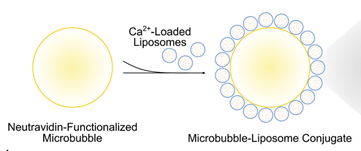In today’s thread, I want to talk about some other fun things we do with sound!
I& #39;ve been lucky to work with a brilliant team ( @NeleValeria @AcoustiCarolyn) on an exciting project using sound to trigger #enzyme #catalysis and #gelation!
Read on for more details...
I& #39;ve been lucky to work with a brilliant team ( @NeleValeria @AcoustiCarolyn) on an exciting project using sound to trigger #enzyme #catalysis and #gelation!
Read on for more details...
Our idea was based on using #liposomes - small droplets that can be filled up with different "cargo" (e.g., chemicals, drugs). Under the right conditions, you can use ultrasound to release this cargo into the surrounding liquid.
This cargo can then be used for many things!
This cargo can then be used for many things!
For example, we used ultrasound to release a cargo of calcium ions - these ions could then stick to an enzyme ( #transglutaminase) and activate it so that it could catalyze a chemical reaction.
This was the first example of an ultrasound-triggered enzyme!
But there is more...
This was the first example of an ultrasound-triggered enzyme!
But there is more...
...once the enzyme is activated, it can then turn a liquid solution into a gel ( #fibrinogen)!
This was only the second example of an ultrasound-triggered hydrogelation (the other one used radicals - ours didn& #39;t).
This was only the second example of an ultrasound-triggered hydrogelation (the other one used radicals - ours didn& #39;t).
As usual, we should ask, why is this important?
Well, enzymes are used all across industry and bio-sciences to catalyze chemical reactions, and hydrogels are commonly used as soft biomaterials for cell culture, tissue engineering, drug delivery, soft robotics and lots more...
Well, enzymes are used all across industry and bio-sciences to catalyze chemical reactions, and hydrogels are commonly used as soft biomaterials for cell culture, tissue engineering, drug delivery, soft robotics and lots more...
...and now we have a new way to activate enzymes and make gels!
Unlike a lot of light sources, ultrasound can pass through opaque walls and through the human body, which means we can now start to trigger these processes in previously inaccessible locations!
Unlike a lot of light sources, ultrasound can pass through opaque walls and through the human body, which means we can now start to trigger these processes in previously inaccessible locations!
Another useful thing about this method is that it is "modular" - which means we are not limited to this exact system (calcium, transglutaminase, fibrinogen).
We can switch out the cargo, the enzyme or the gels - something that we are exploring this now!
We can switch out the cargo, the enzyme or the gels - something that we are exploring this now!
We also showed that you can stick the cargo-loaded liposomes onto tiny gas bubbles. Ultrasound can be used to expand, contract and burst the bubbles- which helps to release the cargo even better!
I hope you enjoyed this thread!
For more details, see our Advanced Materials @advscinews paper published earlier this year:
https://doi.org/10.1002/adma.201905914
Shout">https://doi.org/10.1002/a... out also to @jono_woj (and others that aren& #39;t on Twitter) who helped make this happen!
For more details, see our Advanced Materials @advscinews paper published earlier this year:
https://doi.org/10.1002/adma.201905914
Shout">https://doi.org/10.1002/a... out also to @jono_woj (and others that aren& #39;t on Twitter) who helped make this happen!

 Read on Twitter
Read on Twitter



